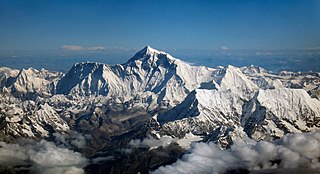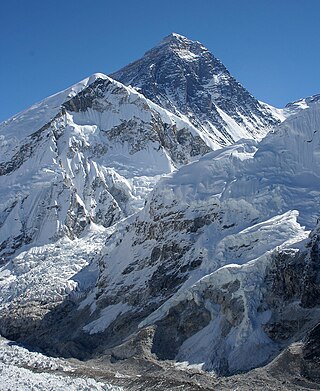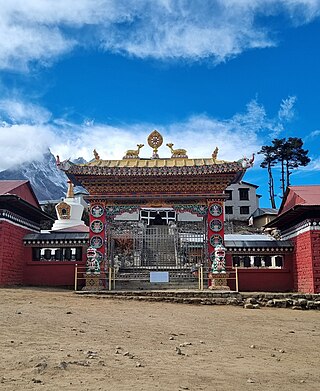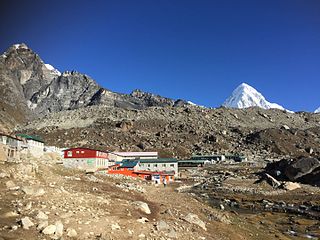
Mount Everest is Earth's highest mountain above sea level, located in the Mahalangur Himal sub-range of the Himalayas. The China–Nepal border runs across its summit point. Its elevation of 8,848.86 m was most recently established in 2020 by the Chinese and Nepali authorities.

Lukla is a small town in the Khumbu Pasanglhamu rural municipality of the Solukhumbu District in the Province No. 1 of northeastern Nepal. Situated at 2,860 metres (9,383 ft) above sea level, it is a popular place for visitors to the Himalayas near Mount Everest to arrive. Although Lukla means "place with many goats and sheep", few are found in the area nowadays.

Tengboche is a village in Khumbu Pasanglhamu rural municipality in the Khumbu subregion of Province No. 1 in Nepal, located at 3,867 metres (12,687 ft). Within the village is an important Buddhist monastery, Tengboche Monastery, which is the largest gompa in the Khumbu region. The structure was built in 1923. In 1934, it was destroyed by an earthquake but subsequently rebuilt. It was destroyed again by a fire in 1989, and again rebuilt with the help of volunteers and the provision of foreign aid. Tengboche has a panoramic view of the Himalayan mountains, including the well-known peaks of Tawache, Everest, Nuptse, Lhotse, Ama Dablam, and Thamserku. Tenzing Norgay, the first man to reach the summit of Mount Everest with Sir Edmund Hillary, was born in the area in the village of Thani and was once sent to Tengboche Monastery to be a monk.

Khumbu is a region of northeastern Nepal on the Nepalese side of Mount Everest. It is part of the Solukhumbu District, which in turn is part of Koshi Pradesh. Khumbu is one of three subregions of the main Kirat Kulung and Sherpa settlement of the Himalaya, the other two being Solu and Pharak. It includes the town of Namche Bazaar as well as the villages of Thame, Khumjung, Pangboche, Pheriche and Kunde. The famous Buddhist monastery at Tengboche is also located in Khumbu.

Kala Patthar is a notable landmark located on the south ridge of Pumori in the Nepali Himalayas above Gorakshep. Although not a proper mountain, with a prominence of only 10 m (33 ft), the ascent of Kala Patthar is very popular with trekkers in the region of Mount Everest since it provides the most accessible closeup view of Everest. Due to the structure of the Everest Massif, its high summit is blocked by Nuptse from much of the surrounding region.

Gorak Shep, also spelled Gorakshep, is a settlement nestled on the periphery of a frozen lakebed blanketed with sand in Nepal, sharing its name with the locale. Situated at an elevation of 5,164 meters near Mount Everest, it remains uninhabited for most of the year, reopening only for the Mount Everest trekking season.

There are two base camps on Mount Everest, on opposite sides of the mountains: South Base Camp is in Nepal at an altitude of 5,364 metres (17,598 ft), while North Base Camp is in Tibet at 5,150 metres (16,900 ft).

The 2006 Philippine Mount Everest expedition is a Filipino mountaineering expedition that made a successful attempt to reach the summit of Mount Everest via the traditional southeast ridge route in May 2006 during the spring climbing season in the Himalayas. It was the first national expedition organized by the Philippines to reach the summit of world's highest mountain.

Everest Marathon is an annual marathon event, held in the district of Solukhumbu, Nepal, around the vicinity of Mount Everest in May. With its starting point at 5401m Meter from where the Climbing of Mount Everest Peak starts through the Ice Fall, the marathon is considered to be one of the highest and toughest races in the world. The marathon starts at the Mt. Everest Base Camp, and moves through the traditionally used high Sherpa trails of Khumbu Valley.

Tengboche Monastery, also known as Dawa Choling Gompa, in the Tengboche village in Khumjung in the Khumbu region of eastern Nepal is a Tibetan Buddhist monastery of the Sherpa community. Situated at 3,867 metres (12,687 ft), the monastery is the largest gompa in the Khumbu region of Nepal. It was built in 1916 by Lama Gulu with strong links to its mother monastery known as the Rongbuk Monastery in Tibet. In 1934, it was destroyed by an earthquake and was subsequently rebuilt. In 1989, it was destroyed for a second time by a fire and then rebuilt with the help of volunteers and international assistance.

Lobuche is a small settlement near Mount Everest in the Khumbu region of Nepal. It is one of the last overnight stops with lodging on the "trail to base camp", a hike that climbers make on their way to Everest Base Camp (South) when attempting an ascent of Everest via the standard southeast route. It is also a popular stop among trekkers in the area. From there they can complete the trail on to EBC or stop at Gorak Shep, the last stop with lodging on the trail, and climb the modest nearby peak, Kala Patthar, for a rare view of the Everest summit. The structure of Everest is such that its actual summit is not visible from Base Camp.

Monjo is a small village in the Khumbu region of Nepal. It lies in the Dudh Kosi river valley just north of Phakding and south of Jorsale, at an altitude of 2,835 m, just below the Sagarmatha National Park entrance gate and check-point, one of the UNESCO World Heritage Site since 1979.

Phakding is a small village in the Khumbu region of Nepal. It lies in the Dudh Kosi river valley just north of Lukla and south of Monjo, at an altitude of 2,610 m, one of the UNESCO World Heritage Site since 1979. Phakding has a population of 550 locals, mostly Sherpa and Tamang. All of these people belong to Tibetian Buddhism and pray in a small Gompa at the centre of the village.

Jorsale is a small village in the Khumbu region of Nepal. It lies in the west side of the Dudh Kosi river, just north of Monjo and south of Namche Bazaar, at an altitude of 2,740 m,

Jaahnavi Sriperambuduru is an Indian mountaineer and motivational speaker. She is on her mission to climb the highest peaks of all seven continents known as the Seven Summits and also to reach the farthest point on the globe "The South Pole" and "The North Pole".

Kuntal Joisher is an Indian mountaineer based in Mumbai. On 15 May 2018, he stood on top of Mt. Lhotse, the fourth highest mountain in the world at 8516 meters. During the course of the expedition, Joisher only consumed strictly vegan food, and used only vegan gear including a one-piece synthetic suit made completely from animal-free material, as well as mittens and gloves constructed devoid of down or leather.

Khumbu Pasanglhamu is one of 7 rural municipalities (Gaunpalika) in Solukhumbu district of Province No. 1 of Nepal. Khumjung, Namche & Jubing and Chaurikharka were incorporated while creating it. It has the total population of 9,133 according to the 2011 Nepal census and area of 1,539.11 square kilometres (594.25 sq mi). The admin centre of this gaunpalika is that of the Chaurikharka.

Ratnesh Pandey is an Indian mountaineer, who climbed Mount Everest in 2016.
Everest Link is an internet service provider founded in 2014 that provides high-speed internet and Wi-Fi in the remote Everest Region. It is the only internet provider at the Everest Base Camp, located at a height of 5,380m, making it the world's highest internet service. Before Everest Link was set up at the Base Camp, climbers solely relied on satellite phones for communication.

Bhawna Dehariya is an Indian mountaineer born in Village Tamia, District Chhindawara, Madhya Pradesh. She climbed to the summit of summit of Mount Everest on 22 May 2019. She holds a Guinness World Records title for promoting and popularising Indian Himalaya with the Himalayan Mountaineering Institute on 15 August 2020. She is the Vice President and Brand Ambassador of Jan Parishad, a national level social enterprise.

















